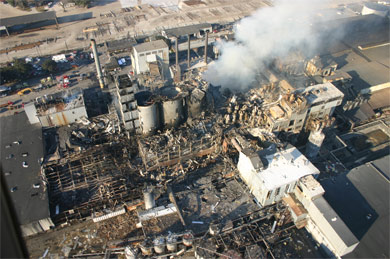Another Congress, another combustible dust bill
On Feb. 8, Rep. George Miller (D-CA) introduced a bill that would force OSHA to issue a combustible dust standard. This is the third time Miller has introduced such a bill and, in all likelihood, it will fail to become law once again.
The math for the bill just isn’t there. Republicans, now in the majority in the House, voted unanimously against the bill when it passed out of the then-Democrat controlled House in 2008. In the previous Congress the bill didn’t even get a vote in committee, likely due to other pressing matters such as attempts to strengthen the Occupational Safety and Health Act and improve mine safety (which also failed).
It’s hard to see House Republicans allowing this to come to a vote, let alone passing it, given their recent statements on how additional regulations could hurt economic growth. I wouldn’t be surprised to hear familiar arguments against the bill: It will interfere with the regulatory process; more time is needed to study the hazard; the standard will be too expensive for businesses.
This would be disheartening. OSHA’s regulatory process (.pdf file) is not terribly efficient and certainly not swift. In the past five years, the Chemical Safety Board has completed two investigations into combustible dust hazards, each time calling for OSHA to issue a general industry standard. And although costs may be involved in testing deflagration levels and housekeeping measures, they are sure to be less expensive than the costs a combustible dust explosion will bring – both in lives and dollars.

Even George W. Bush-appointed CSB member and former board chair John Bresland said a standard may benefit companies. “A company that experiences a major dust explosion can expect to receive a fine from OSHA, as Imperial has,” Bresland told (.pdf file) a Senate committee two years ago. “But absent a standard, thousands of other companies that may be at risk do not benefit from clear instructions about what kinds of dust are most hazardous and what training and controls should be put in place.”
Between 1980 and 2005, 119 people died and 718 were injured in combustible dust explosions. Since the 1987 promulgation of OSHA’s grain industry dust standard, deaths and injuries from dust explosions and fires have dropped more than 50 percent. Issuing a similar standard for the general industry could save many lives.
Too bad it’s probably not going to happen anytime soon.
The opinions expressed in "Washington Wire" do not necessarily reflect those of the National Safety Council or affiliated local Chapters."
Post a comment to this article
Safety+Health welcomes comments that promote respectful dialogue. Please stay on topic. Comments that contain personal attacks, profanity or abusive language – or those aggressively promoting products or services – will be removed. We reserve the right to determine which comments violate our comment policy. (Anonymous comments are welcome; merely skip the “name” field in the comment box. An email address is required but will not be included with your comment.)

